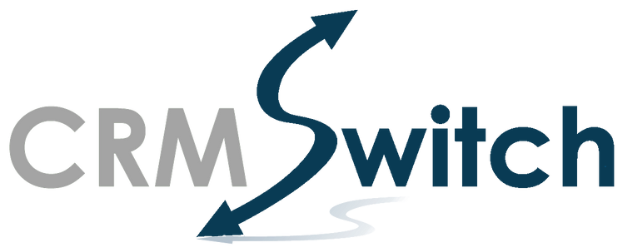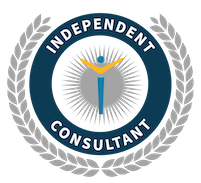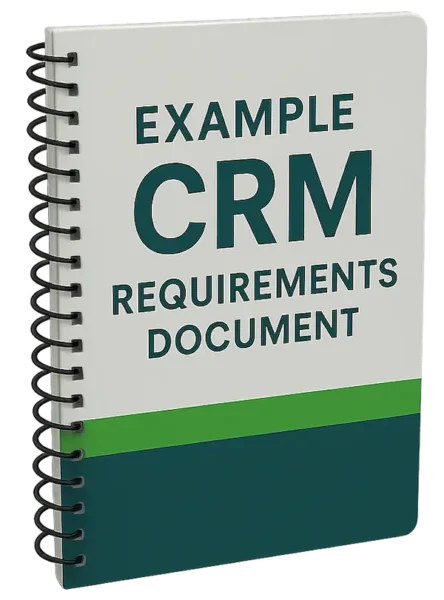As many Customer Relationship Management software vendors have upped their game, CRM selection has become more complex over the last several years. The playing field is more level than ever.
While healthy competition ultimately benefits all organizations, an abundance of choices makes it more difficult for those tasked with selecting the right CRM solution for their company to achieve the optimal outcome.

Because of the volume of marketing messages from leading CRM vendors, many people start the CRM selection process by visiting software review sites, signing up for free trials, and scheduling demonstrations with the leading vendors.
However, when the CRM selection process begins with vendor demonstrations, the evaluation cycle can take much longer than everyone, including the vendor representatives, wants.
An extended selection timeline has many hidden costs. Choosing the wrong product can result in large multi-year expenditures with little return.
Recommended Steps for CRM Selection
The following is a planning and selection sequence that we recommend to anyone we talk to, whether or not they ask for our help.
Adding structure will accelerate the overall process rather than slowing it down.
Postponing activities such as vendor demonstrations and product feature comparisons usually favors the buyer.
Step 1 – Interview Stakeholders and End Users
To be the most successful, a CRM solution must address the needs of both management and end users.
Input from would-be end users is highly valuable to the CRM selection process. End users spend the most time interacting with prospects and customers.
They are well-equipped to relay observed inefficiencies and user pain points with the current systems. These users may have already developed creative solutions that could be handled within a more robust platform.
When the right questions are asked, operational inefficiencies and customer dissatisfaction that management may not even have been aware of will often surface.
In addition, if end users are early participants in the process, they can experience a cognitive bias that makes them more willing adopters of a CRM solution once it’s rolled out.
Participants in the interview stage should extend as far up the organization as possible.
Step 2 – Assemble and Analyze the Input
Once the information has been gathered from participants, it needs to be organized and analyzed. User input will emerge with recurring themes. Additional questions may need to be asked of management and end users to fully capture the current state and the optimal future state.
The functionality and performance levels of existing systems and processes (including manual processes) should be cataloged and described in reasonable detail.
Relevant details about existing data systems—ranging from shared spreadsheets to the company’s ERP system—and how these systems are currently functioning or not functioning, should be part of the analysis.
This step’s output is usually a working document and a summary presentation that will become integral to the next step. A condensed version of the summary presentation can also be used in Step 5.
Step 3 – Validate and Prioritize
Thorough execution of Steps 1 and 2 will result in considerable information that needs to be reviewed and validated.
Assembling the input for validation is best accomplished through a workshop that includes stakeholders and representative end users. The workshop is a means of communicating, confirming, and discussing various details with participants.

Once this information has been presented to and discussed with the assembled group, decisions can be made on which requirements to address first and which to defer until later.
This step also includes a shortlist of vendors to consider. The vendor list may need to include point solutions and third-party add-on solutions.
Step 4 – Develop a Vendor Ranking System
After a prioritized list of requirements has been developed, this information should be organized so that participants can rank vendors based on each vendor’s platform’s ability to meet the documented requirements.
A ranking system can also serve as a general demonstration guide for vendors. This way, they can ensure that they address the highest priority requirements and address requirements in a logical sequence as they walk the team through the details of their CRM platform.
A ranking system should focus on functionality and the ability of each prospective vendor platform to address requirements rather than on generalized features.
Step 5 – Schedule Tailored Presentations
Prospective vendors and/or their channel representatives should be pre-briefed on your organization’s current and desired future state. They should understand your company’s functional areas and the roles within them.
Ideally, each prospective vendor representative will deliver a customized demonstration of their solution. It’s up to each vendor to determine how much time they want to spend tailoring their demonstration system.
However, it’s generally in a vendor’s best interest to provide a complete picture of how their solution will solve your organization’s most important business issues.
While a full ‘proof of concept’ often requires a paid engagement, most vendors are willing to put in the effort to ensure that the benefits of a solution built on their platform can be demonstrated to a sufficient extent.
A single presentation by each vendor is not always enough. Vendors may need to research specific details and then follow up with you. For example, a subsequent technical deep dive session may require your team to understand how legacy system integration requirements will be addressed.
Step 6 – Select the CRM Solution
After the demonstrations, there will invariably be follow-up questions for vendors regarding specific functionality and how it will be delivered.
The participants’ vendor rankings should be consolidated into a single document. While the correct path is often apparent at this point, the rankings can be further scrutinized in the case of a close call.
A final vendor selection should be made during this step, and an implementation timeline and strategy should be determined. Initial implementation estimates can be requested from vendor partners at this stage. Enough information will have been collected to provide would-be implementation companies with a solid basis for their initial estimates.
Step 7 – Negotiate and Procure
Once your team has chosen a CRM vendor, additional work must be done. The CRM vendor you select may offer multiple editions of its product, and may allow mixing and matching functionality licenses within an edition. Licenses may be needed to enable specific features or to meet storage requirements.
Your organization may get better overall pricing for pre-purchasing licenses that will not be deployed during the initial rollout. On the other hand, it might make more financial sense to initially commit to a subset of the user licenses that will ultimately be needed — and purchase additional licenses later.
Your CRM deployment may include specific add-ons or complementary technologies. Pricing and purchase timing need to be determined for these as well.
There can be multiple options for the contract duration. The optimal contract duration should be determined at this stage.
Other Benefits of a Structured CRM Selection Process
It’s worth noting that a formal process for choosing the right system provides many more benefits than just making a CRM vendor decision.
Since the selection process involves defining requirements around your overall CRM process, it provides a significant head start toward the eventual CRM implementation.
Gathering requirements early on also allows more time to expand on specific ideas and refine priorities, compared to beginning the requirements-gathering process after payments for the new CRM system have already begun.
The process outlined above will give senior management a clearer picture of the organization’s operational components. Beyond the CRM selection process, the perspective gained will provide valuable input for strategic thinking and planning.
Formally selecting a CRM system will garner information from employees that has value beyond just CRM. Employees have an opportunity to provide feedback that can ultimately increase their job satisfaction and the quality of service they can provide to customers.
An Interview With Daryn About The Selection Process
Full Transcript
STEVE: Hi, this is Steve Chipman. Today I am joined by Daryn Reif, practice manager for CRM Switch. Greetings, Daryn.
DARYN: Hey, Steve, how’s it going?
STEVE: Going well.
So today, we’re going to discuss the planning and selection process for CRM marketing automation and related applications.
So Daryn, let me start with a general question.
What should people be doing that they’re not currently doing to determine what’s the best CRM system or marketing automation system for their business?
DARYN: Well, Steve, I’d say it’s more of what they shouldn’t do, which is run out and do a demonstration. You know, we really propose that people shift their approach from a product evaluation to more of a solution evaluation, where focusing on the process of the business and what the needs are to facilitate those processes are really taking the forefront. So rather than gathering a team together, which is expensive for for many organizations, and doing a canned demonstration where you’re likely not going to see what it is that you really need to see to make an evaluation, that instead, stepping back and defining what it is that we need and the processes that we need to support, at the same time, maybe cultivating a pride of authorship amongst the team from management on down, and and then aligning all the departments and all the levels of management as to what’s a successful CRM or marketing automation solution would do for the organization. That would be my recommendation.
STEVE: So, in order to avoid getting into that canned demonstration trap, what are the steps you take to ensure that the process is more disciplined and that people see demonstrations that are more specific to their business needs and not sort of a generalized representation of the application or applications?
DARYN: Sure. Sure. So, over the years, we’ve honed our process down to a seven-step process. It starts with discovery, which is really about interviewing the different folks in the organization, as I said, from the top down, to really understand the pains, the challenges, their hopes and their dreams about CRM or marketing automation and what it’s going to do for them. We then, the next phase is memorializing those requirements. And that’s usually done in maybe a PowerPoint presentation or something that can be a work product that leads to the third step, which is a workshop. And I like to tell people the workshop is a bit of a cage match where we get the stakeholders together and we, we don’t leave the room until we’ve validated, prioritized, and actually built a consensus about what is in scope, what is out of scope, what the priorities are with regard to our needs. Fourth, we’ll establish a scoring methodology, and that might be a scorecard or it might be a proof of concept. It depends really on the outcome of the workshop as to what the scoring methodology is going to be so we can all be evaluating the solutions using the same process. And then we’ll do tailored demonstrations. And tailored demonstrations are really where we’ll sit down at CRM Switch with the sales engineer and account engineer for the different vendors, and we’ll take them through the workshop, which has all of our requirements. We’ll take them through the scoring methodology if that’s a scorecard. And they’ll understand what they need to be doing as far as arranging and tailoring their demonstrations in order to get the best score, if you will, or the most favorable response from us. That will ensure that they’re showing what we need to see rather than, you know, the latest, brightest, shiniest object that they’re marketing.
So, steps six and seven. Six is a findings and recommendations report, and that’s something that can be handed to a board or an executive committee that includes our findings, our recommendations, the solutions to the potential to the pains that we’ve seen. And then lastly, the negotiation and procurement, where we don’t do the negotiation, but we help you through that process, giving some tips and tricks about how to get the most out of your purchase.
STEVE: And as defined by their roles, who are the people you normally work with within an organization? I know it can vary from organization to organization, but who are the typical levels of people or job positions that you tend to work with on these engagements?
DARYN: Well, I usually look at an organization in terms of maybe five personas, if you will. The first being the keepers of the tribal knowledge. Those are the folks that in your organization that really are the masters of the undocumented. They know where the bodies are buried. They know how things are done, even if it’s not written down somewhere. And so they’re they’re important to talk to. The lifers are another group. Those are the folks that have been in the organization for a long, long time, and they maybe worked worked in multiple departments or they’ve worked their way up in the organization. So they really have a multi-multidisciplinary view of the organization.
Also, we have what we call the hard cases. Those are the folks that, you know, maybe be reticent to make a change as far as how they do their business. Maybe they’re fearful of change. So we need to talk to them. We need to understand, you know, why they’re concerned or what their fears are. We need to get those on the table and make them part of the process.
We have the suffering, which is another the last one of the last groups, which is the folks that are really feeling the pain, the ones that have that are probably driving this process because they really require change to be able to move the organization in the direction that they they they think it should go. And then, of course, last, we have the money bags, which are those who hold the purse strings, the CFO, the CEO, or an EVP. And they need, their voice needs to be heard, obviously, and they need to be part of this process because in the end, they need to make a a decision, a financial decision, about whether this is the right thing for the organization and if there’s going to be a return on the investment.
STEVE: Does it matter what industry you’re in or whether you’re for-profit or nonprofit for the process that you’ve described to work?
DARYN: As far as industry, it really doesn’t matter. As I mentioned, we take more of a process process-centric approach, and it tends to always boil down to sales, or service, or communication. So, it really doesn’t; it’s not really dependent on the industry. I can just say we’ve used the same approach, the seven-step approach that we use, with insurance companies, folks in the financial services sector, manufacturing, software, media, I mean, the list goes on. So, we feel pretty confident that that process is ubiquitous. I will say that there are some really great vertically oriented applications out there for specific industries, and we don’t know them all. We do run across them, but it is our job to keep up to speed as they continue to pop up, because sometimes that’s the right solution.
STEVE: And what would you say are some of the advantages of using a third party to go through the process you’ve described rather than trying to take care of things internally?
DARYN: Well, the obvious advantage is that we’ve done it before. So that, you know, the discovery process is certainly going to be improved as we understand and we know how and what questions to ask to get to the heart of the matter and what the real issues are or what the real objective is. We also are pretty good at exposing opportunities for improvement and strategic advantage, which is really where we’re going to get the ROI. And, you know, we we can many times reveal pains and risks that should be addressed through the conversations that we’re having with folks, because you have to remember that in organizations, many times it’s easier for a third party to really get the straight skinny, where staff might be more forthcoming with folks that are not in management or not from IT who may have built the systems that they’re looking to replace. So, I’d say discovery, improved discovery is a big one. And project acceleration is probably another big one. Usually, folks that contact us, you know, are somebody from IT or sales or marketing who has sort of either taken the torch or been handed the torch to initiate change. And they have full-time jobs. I mean, they have a lot to do, you know, selecting a CRM or a marketing automation system is not in their job description. There’s no time allocated for it. So, they do the best they can, but that typically results in this process taking an elongated period of time. So, when we get involved, we energize the process, we drive the project forward by pushing and pulling as necessary to deliver an end result.
STEVE: Now, some of our listeners’ minds might be jumping to cost. What would something like this cost? But without blurting out a number, what are the parameters you use to estimate what the scope of an engagement like this is going to be for an end customer?
DARYN: Well, we first will have a discovery call. It doesn’t cost the customer anything just to understand whether we’re talking about a CRM engagement or a marketing automation engagement or both, or maybe something that’s grander than the two. So that that’s that’s one piece. The number of stakeholders that need to be interviewed and sort of wrestled to the ground to get their requirements out of them, that certainly has an impact. And then lastly, the number of systems that are customer-centric that may need to be integrated or may need to feed or be fed by these other systems is sort of the final component.
STEVE: And you mentioned earlier a couple of the deliverables from this engagement. Is the client able to use the deliverables as a foundation for what will hopefully be an eventual implementation of a CRM and or a marketing automation system?
DARYN: Oh, sure. The output of the workshop where we’ve validated, prioritized the high-level business requirements is a CRM blueprint of sorts. I mean, it includes the customer touchpoints, it includes the integration priorities, it includes, you know, some of the decisions that had to be made at that point for selection purposes that will drive how the CRM or marketing automation tool will be implemented. So, that with the findings and recommendations document, which includes the high the pains that have been identified and possible solutions, those two are great tools for the implementation team when they get to implementation because they don’t have to go do all that groundwork. It’s already been done, and it’s already been agreed to, so they can just, you know, kick off the implementation without looking back.
STEVE: And so the final question is, once a decision has been made on a system or systems, what happens next? What’s the next step?
DARYN: Well, that really has to do with the solution that’s chosen. Now, when we enter an engagement, there’s no predisposition to what the right tool is, the right solution. So, we go through the process. We end up with the best solution for the client. And at that point, we have a network of trusted partners that we can recommend for all the major solutions. So, we can help through that process. And if our client doesn’t have an internal project manager, we can continue on in that capacity to ensure that the client, you know, actually does get married and is not just left at the altar, as they say.
STEVE: Great. Thank you very much for your time, Daryn. And if people want more information, they can go to crmswitch.com, right?
DARYN: Correct. Thanks for having me, Steve.
STEVE: My pleasure. Take care, Daryn.



